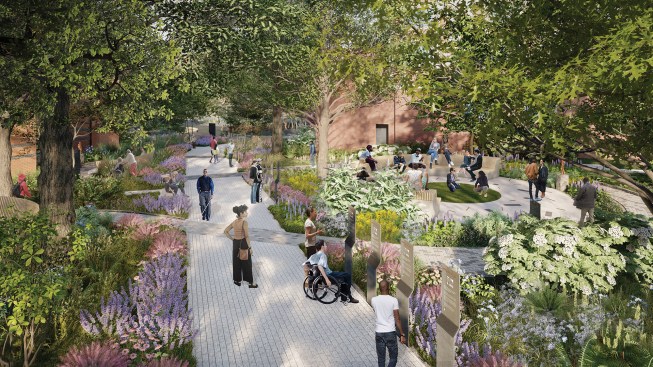I often say that I am a child of the 1990 Americans with Disabilities Act, which became law around the same time I started my education. Attending a Deaf school, I also saw the remnants of outdated ideas around Deafness and disability that placed Deaf schools on the margins of society, shaping attitudes towards disability and community.
More recently, while confronting the COVID-19 pandemic, the public asked architects why our buildings make us sicker. The Architecture of Health: Hospital Design and the Construction of Dignity, a book I co-authored in 2021, explores this question and unearths how architecture has been influenced by developments in healthcare. It also reveals how historical examples can offer us caution and inspiration.
Through my work on the book and an accompanying exhibition at Cooper Hewitt Smithsonian National Design Museum, what I had always known intuitively became clear: Deaf schools and spaces of disability share the same lineage with other architectures of exclusion, including prisons, state hospitals, and Native American boarding schools. These institutions either were located on the periphery of our cities–out of sight and out of mind, surrounded by stone walls or fences–or they were designed with enormous public expenditures and in a manner that inspired civic pride, social virtue, and public confidence. Within these walls, “professionals” claimed to possess a higher authority, whether through God or medicine, and set about conditioning and reforming bodies that deviated from the mold of the ideal citizen.
Justice is understanding access as fundamental to dignity. Disability justice further recognizes that disability and ableism frequently intersect with other forms of oppression based on race, ethnicity, class, and gender.
Such was the case of Tule Lake War Relocation Center, in Tulelake, Calif., where after President Franklin D. Roosevelt issued Executive Order #9066 in 1942, my grandmother Miyoko became one of more than 125,000 Japanese Americans to experience forced removal and mass confinement. Like many others who endured this imprisonment, she never shared her experience. As a result, our generation is left with an incomprehensible sense of intergenerational loss.
In Bismarck, N.D., a little-known World War II-era internment camp once stood on what is now the site of the United Tribes Technical College. With UTTC, MASS Design Group is designing the Snow Country Prison Memorial to WWII Japanese American Internment, reusing the original slate roof tiles that once covered the barracks of the camp to create a curved wall inscribed with the names of those who were imprisoned there. A slot in the wall invites visitors to place paper cranes–tsuru–that symbolize hope. This wall of names surrounds a ceremonial circle, signifying the solidarity between the Japanese American and Native American communities.
As a Yonsei, or fourth-generation Japanese American, I often think about the intersection of architecture, landscape, and identity, as well as how we access our cultural stories. In our built world, there are few spaces where we can access the cultural memory of Deaf and Disabled communities.
Deaf and Disabled people are born designers; we are constantly redesigning a world not designed for us
Our built environment has systematically disempowered, displaced, and disenfranchised countless communities. To me, justice means creating not only access to space, but to citizenship, social mobility, healthcare, food, and joy. Justice is understanding access as fundamental to dignity. Disability justice further recognizes that disability and ableism frequently intersect with other forms of oppression based on race, ethnicity, class, and gender.
The Deaf Space and Disability Justice Design Lab, established in 2021 at MASS, works to uplift the lived experiences of Deaf and Disability communities. We have provided design expertise on healthcare, housing, and educational projects. As we have learned, true justice requires us to go beyond the legal definition of access. Focusing on codes, rights, and law is essential, but not enough; this approach leads to a scarcity mindset. To instead seek abundance is an act of love, the greatest form of resistance.

MASS Design Group with TEN x TEN
A rendering of the Louise B. Miller Pathways and Gardens at Gallaudet University.
With the Louise B. Miller Pathways and Gardens at Gallaudet University in Washington, D.C., a global leader in bilingual education for Deaf and Hard-of-Hearing students, MASS is designing a memorial honoring civil rights activist Louise B. Miller, who fought to desegregate deaf education. At the site of a formerly segregated school on the campus, we are working with Louise’s children and Gallaudet´s Center of Black Deaf Studies, founded in 2020, to implement Black Deaf Space Principles, including space for freedom, gathering, and grace, to transform the site from a place of historical deprivation to one of abundance.
Deaf and Disabled people are born designers; we are constantly redesigning a world not designed for us. This is not a zero-sum game, but one that has the power to lift up more people through thoughtful consideration of space, place, and history. Abundance is possible if we let it be the rule, and not the exception.
This article first appeared in the April issue of ARCHITECT.
Read more: Melanie Fairchild and Jessica Dole on parental leave in the architecture profession|Gabriel Keller on alternative pathways to professional licensure|Ali Wolf on restoring affordability in the housing market
